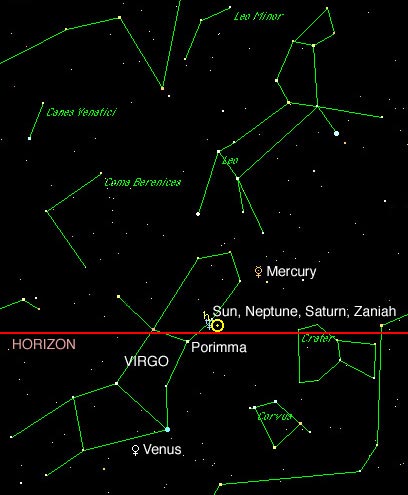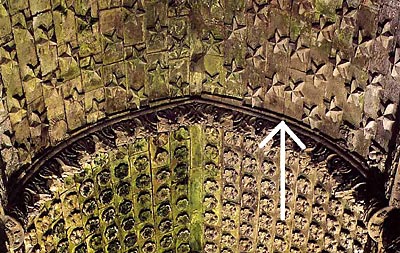(Originally published in Atlantis Rising #38 – March/April, 2003. All photos, except for the two pillars, are by Antonia Reeve for the Rosslyn Chapel Trust. The 9/21/1450 sky was calculated in the Skychart III program, available at www.southernstars.com)
Rosslyn Chapel sits just six miles south of Edinburgh, Scotland’s ancient capital city. Built in the 15th century by Earl William St. Clair of Rosslyn, the chapel has become one of the most mysterious and controversial buildings on Earth. Recent years have seen the controversy reach fever pitch as an adversarial band of alternate-history researchers, freemasonic “seekers of light,” and treasure hunters vie to unlock the secrets they feel are hidden within the chapel walls.
The stakes are high.
At last tally, these intrepid questers have variously speculated the chapel hides the Long-Lost Treasure of the Knights Templar, a piece of the “True” Cross, Scotland’s Stone of Destiny, the mummified head of Christ, and even that Holy Grail of relics—the Holy Grail, itself.
A world-class collection, no doubt—but none has yet been found. Rosslyn keeps its secrets well.
London businessman and St. Clair descendent, Niven Sinclair is fond of saying that William built Rosslyn Chapel “at a time when books could be burned or banned, so he left a message for posterity chiseled out in stone.” Niven’s pet project, into which he has sunk a great deal of energy over the years, is to prove that William’s grandfather made a voyage of discovery to America almost a century before Christopher Columbus made the voyage that history has approved.
Niven also believes that Christ did not die on the cross, but survived to sire children with his wife, Mary Magdalene. This marriage begat a bloodline that has flowed down the centuries through several high and mighty European families, including Niven’s own. But it is still the Biblical tale of Christ’s ascension that wins the popular vote in the credibility department, so Niven soldiers on.
While the expression “carved in stone” has become synonymous with the “unchangeable,” that’s not the case with Rosslyn. Some very significant changes have been made within the chapel walls, and then concealed.
Let’s take a look.
The interior greets the eye with such a visual feast of carved stone that one barely knows where to begin. Strange foliage and figures hang everywhere about the walls, arches and ceiling, like icing on a cake. And while the overall effect was clearly meant to be Christian, closer inspection reveals that many carvings have their symbolic origins in quite different ideologies, some of them decidedly Pagan.
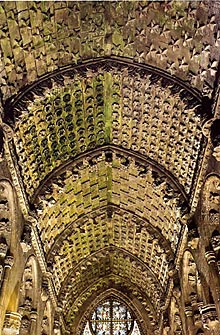 Here and there you’ll find the head of a “Green Man,” an ancient Celtic vegetation god, peering out from within the carved foliage, and on Rosslyn’s most celebrated structure, the “Prentice Pillar,” a daisy chain of dragons nibble away at the roots of what’s been interpreted as the Nordic “Tree of Life.” Add to the mix carved tales from the Hebraic Old Testament, and legends that resonate with Templar and Freemasonic lore, and you have an architectural recipe for perennial success. And except for a few dicey years during the Reformation, when Protestant zealots took stern issue with what they called “idolatry,” the chapel’s been successful ever since.
Here and there you’ll find the head of a “Green Man,” an ancient Celtic vegetation god, peering out from within the carved foliage, and on Rosslyn’s most celebrated structure, the “Prentice Pillar,” a daisy chain of dragons nibble away at the roots of what’s been interpreted as the Nordic “Tree of Life.” Add to the mix carved tales from the Hebraic Old Testament, and legends that resonate with Templar and Freemasonic lore, and you have an architectural recipe for perennial success. And except for a few dicey years during the Reformation, when Protestant zealots took stern issue with what they called “idolatry,” the chapel’s been successful ever since.
But while certain details have been added to the chapel over the years, it’s considered that the original language of Earl William’s “book in stone” has remained unchanged. On my last trip to Scotland, however, I found several dusty guides to Rosslyn that, here and there, tell a different tale.
Let’s walk to the center of the chapel and look up.
Rosslyn’s great barrel-vaulted ceiling is divided into five courses. Four courses have a floral theme, each with its exclusive tile, which repeats, in cookie-cutter fashion, over its entire course. But the fifth course is different from the others. Instead of flowers, it is full of stars—and other things!
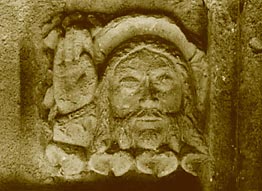 In one corner of the course is a bearded head with an open hand raised alongside. Niven Sinclair has described it as the head of Christ with his hand raised in blessing of his ancestor’s pre-Columbian voyage of discovery. But according to an 1877 article, which ran in Volume XII of the Proceedings of the Society of Antiquaries in Scotland, Andrew Kerr describes this feature as simply “an open hand,” and his observation is corroborated in an 1892 account written by the Rev. John Thompson, Rosslyn’s chaplain.
In one corner of the course is a bearded head with an open hand raised alongside. Niven Sinclair has described it as the head of Christ with his hand raised in blessing of his ancestor’s pre-Columbian voyage of discovery. But according to an 1877 article, which ran in Volume XII of the Proceedings of the Society of Antiquaries in Scotland, Andrew Kerr describes this feature as simply “an open hand,” and his observation is corroborated in an 1892 account written by the Rev. John Thompson, Rosslyn’s chaplain.
Where was Christ’s head and blessing when this “book in stone” was built, and why is it there now?
Three rows up from Christ’s head is the “sun in splendour,” and one row up from the adjacent corner of the star vault is the emerging moon, described in both accounts as a “crescent” moon and “small star.” Nowadays the moon appears to be full, complete with surface features that should not have been observable 159 years before Galileo’s telescope supposedly allowed him to look twenty times closer than anyone had before. What’s been carved into Rosslyn that the founder never intended?
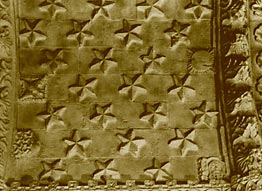 Towards the east end of the chapel stand two pillars that together form the basis for what has become Rosslyn’s most enduring legend—the murder of an apprentice stonemason by his master. Legend has it that the master mason, who had been on a junket to Rome to study the form of a pillar he meant to duplicate in Rosslyn, returned to find that his apprentice, inspired by a dream, had finished the job before him, The master, in a fit of jealous rage, slew his apprentice with a single blow to the head.
Towards the east end of the chapel stand two pillars that together form the basis for what has become Rosslyn’s most enduring legend—the murder of an apprentice stonemason by his master. Legend has it that the master mason, who had been on a junket to Rome to study the form of a pillar he meant to duplicate in Rosslyn, returned to find that his apprentice, inspired by a dream, had finished the job before him, The master, in a fit of jealous rage, slew his apprentice with a single blow to the head.
While both pillars are glorious, the Prentice Pillar clearly outshines the Master’s.
Kerr’s report, while giving lip service to the Apprentice Legend, refers to the Master’s Pillar as the Earl’s Pillar, and in John Slezer’s 1693 “Theatrum Scotiae” the Prentice Pillar is called the Prince’s Pillar. A 1774 account by Bishop Forbes of Caithness postulates that Slezer was referring to the founder’s “princely origins” as last Prince of Scotland’s Orkney Islands.
Confusing, I know.
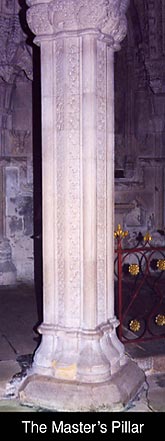
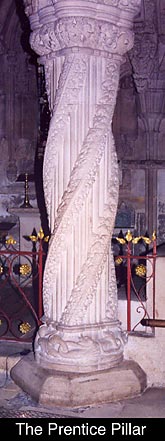 To add to that confusion, back below the star vault is a carved head much studied by Freemasons. Tradition claims it is the head of the slain apprentice complete with fatal wound—a tale that resonates with the Freemasonic legend of the death of Hiram Abiff, architect of Solomon’s Temple, who died in similar fashion. It has been noticed, however, that the apprentice’s chin may have once sported a beard that was subsequently chiseled off. Indeed strange, considering apprentices did not grow beards back then.
To add to that confusion, back below the star vault is a carved head much studied by Freemasons. Tradition claims it is the head of the slain apprentice complete with fatal wound—a tale that resonates with the Freemasonic legend of the death of Hiram Abiff, architect of Solomon’s Temple, who died in similar fashion. It has been noticed, however, that the apprentice’s chin may have once sported a beard that was subsequently chiseled off. Indeed strange, considering apprentices did not grow beards back then.
Master, apprentice, earl or prince—who’s who? Is it possible that a fairly elegant “shell game” has been carved into Rosslyn’s “Book In Stone” that the founder never intended, leaving us still searching for his elusive pea of Truth?
In 1954 the chapel was diagnosed by Scotland’s Ministry of Works as suffering from extreme damp. It was decided to coat the chapel’s interior with a “cementinous slurry” meant to keep the moisture out. Instead, it made matters worse. But it did more than that. Since fresh paint can cover a multitude of sins, the recent changes are no longer noticeable, and I have it on good authority that the cost of the slurry’s removal, if even possible, would be prohibitively expensive. Rosslyn’s fabled “Truth that Conquers All,” it seems, must wait for better days. Or must they?
Increasingly thought to be the premier Illuminati of his day, Earl William built into his chapel something that could never be changed—something that has waited to be noticed for a very long time. And considering that the Knights Templar were ostensibly founded to protect Christian pilgrims on their way to the Holy Land, and that the Earl’s male progeny became “hereditary Grand Masters” of the Freemasons until the beginning of the 18th century, William’s wildcard might come as a bit of a surprise.
Rosslyn Chapel was founded upon St. Matthew’s Day, 21st September, 1446, and officially dedicated to that saint on the same day in 1450. Since September 21 marks the Autumnal Equinox, when the sun rises exactly due east of Rosslyn, I decided to see if the Earl had written something in the sky above, that might have reflected the truth he’d been carving on the earth below. I wasn’t disappointed.
My previous Atlantis Rising articles propose that an “inner circle” of the Knights Templar escaped the order’s suppression in 1307 France, going “underground” in Scotland, while continuing to send what they believed to be “Truth” forward to more enlightened times by secretly hitching rides on both the astrological mythologies of a past they believed to be rooted in “fact” and the astronomical discoveries they knew would be found “when the time was right.”
Thought to have introduced both Chess and Tarot Cards to medieval Europe, the brotherhood quietly and strategically wove long-forgotten truths into the warp and weave of the historical record—truths that would only be seen by those “with eyes to see,” and heard by those “with ears to hear.”
Earl William knew that even a book “carved in stone” could be pounded to dust, so he wrote his testament on the inviolable daytime sky, and hid it in the light.
In “Rosslyn: Guardian of the Secrets of the Holy Grail,” by Tim Wallace-Murphy & Marilyn Hopkins, the authors claim that the site had been “revered by the Druids as the oracle of Saturn, the supreme Guardian of Secrets.”
According to my research, it seems they are right.
When Rosslyn was dedicated on September 21, 1450, the sun had risen exactly due east. Throughout the day, behind the sun and in exact alignment with the Earth lay the planets Saturn and Neptune, a conjunction that occurs only once every 36 years. And they all rose invisibly in the light of day within the constellation Virgo, symbolic of various Goddesses found in diverse astrological traditions.
Following the parallels I’ve drawn in my previous articles between the belief systems of ancient Egypt and Scotland, however, it’s interesting to note that a Greek tradition proposes the Sphinx was originally constructed with Virgo’s head on Leo’s body. It’s also interesting to note that the head of the Sphinx we see today looks disproportionately small, and newer, when compared to the much-weathered body—as though carved “back” from a previous head. And before the weathering of the body, today’s head would have looked even smaller. Another tradition identifies Virgo with the Egyptian goddess Isis—clasping the infant Horus, last of the divine kings, in her arms. Since the advent of Christianity, however, Virgo has been identified as the Virgin Mary, with baby Jesus in her arms, But the Templars are thought to have venerated a “Black Madonna,” not the white one that Christian artwork has promoted for so long, so perhaps it was considered safe enough to leave the door to past belief systems open just a crack.
Far beyond our solar system, yet within the same alignment, lay the star Zaniah, known to the Chinese as “Heaven’s Gate.” The alignment’s next nearest star, Porrima, was also called Antevorta and sometimes Postvorta, two ancient goddesses of prophecy. Curiously, the star was eventually discovered to indeed be a two-star system, and so we might draw an interesting parallel between Porrima and the “debunked” theory of Africa’s Dogon tribe and it’s knowledge of Sirius B.
In any case, the alignment on Rosslyn’s dedication to St. Matthew indicates that several dedications were made—but only Matthew’s was “official.”
Before we leave Rosslyn, let’s again look at the star vault. The rows of stars alternate in chessboard fashion, except for two. Each of the two meets and mirrors the other, thereby reversing the order over the remainder of the course. Is this just another change that’s been made in the architectural fabric of Rosslyn, or is it a part Earl William intended to survive? Many world “myths” describe a day “the sky fell” and the heavenly order changed, an observed phenomenon much explained if the crust of the Earth had suddenly slid around its core, moving parts of the Earth out of (and parts into) polar regions, and causing the world’s oceans to slosh over the land in a cataclysm now known to Christians as the biblical flood! It makes sense that it was not the great Universe that moved—it was us. Two rows up from Rosslyn’s full moon is a dove with an olive branch in its beak. Could it be that William meant the dove to be Noah’s messenger of hope at the flood’s subsidence?
When the Templars were suppressed on Friday, October 13, 1307, it’s thought that the escaping Templar fleet, carrying the order’s inner circle, headed towards Scotland with their treasure and their truth. Hidden below that dark night’s horizon was the same rare alignment that rose at daybreak on Rosslyn’s dedication, but this time a second “undiscovered” planet, Uranus, had conjoined with it. Quite resonantly, considering the events of that Friday the 13th, the alignment lay within Libra, the Scales of Justice. It’s a strong possibility, given such a grand celestial “coincidence,” that the inner circle had decided that “the time was right” for the order’s demise, and had chosen the date to coincide with the alignment. What the hell—they’d all be dead and gone when “Truth” finally conquered “All!”
On November 4, when the Templars may have reached Rosslyn after first gathering secreted stores of arms in Ireland, the sun and moon entered the alignment at dawn—a truly spectacular six-body alignment. And exactly 400 years plus two days after Rosslyn’s foundation date of Sept. 21, 1446, Neptune was finally “discovered,” also during the same alignment. Quite the anniversary gift for those in the know!
[Note: Three years after writing this article I was advised that in 1846, the year Neptune ws discovered, the Autumnal Equinox took place on Sept. 23, so the actual 400th anniversary of Rosslyn Chapel’s foundation date was in fact more exact than I had originally calculated.]
Much has been speculated about what the Templars knew about Earth’s early history not deemed “prudent” to reveal at the time, and how much of that knowledge was passed on to the Freemasons that has since been lost.
Today’s Scottish Templars, whose connection with the original Templars is often hotly debated, have suddenly become uncomfortably pro-active in contemporary events. They have been granted special “consultancy status” with the United Nations, and their current pet project is to bring Jerusalem’s Dome of the Rock under UN control. They meanwhile continue to keep an aloof silence about anything they please. Also avowed to “protect” Scottish history, they have shown no love for my version of it. I have been told in no uncertain terms that while I am entitled to my opinions, they are not “informed” opinions. When I suggested that perhaps “informed” opinions are opinions one has been “informed” about, and so may have little to do with “Truth,” I got silence in reply.
One of the Templars arrested on Oct. 13, 1307, and subsequently interrogated, claimed that during his “initiation” into the order he was shown the Christian cross, and was told “Put not thy faith in this, for it is not old enough.” Is it possible that all adversaries in the current conflict have been “played the fool” over the past few millennia, in order to precipitate the much-prophesized “crisis of faith” that will introduce a new faith the suddenly faithless will flock to?
Is it possible that in order to find the things that once made us friends, we must first discover who’s bright idea it was to make us enemies—and why?
Or is it already too late?

